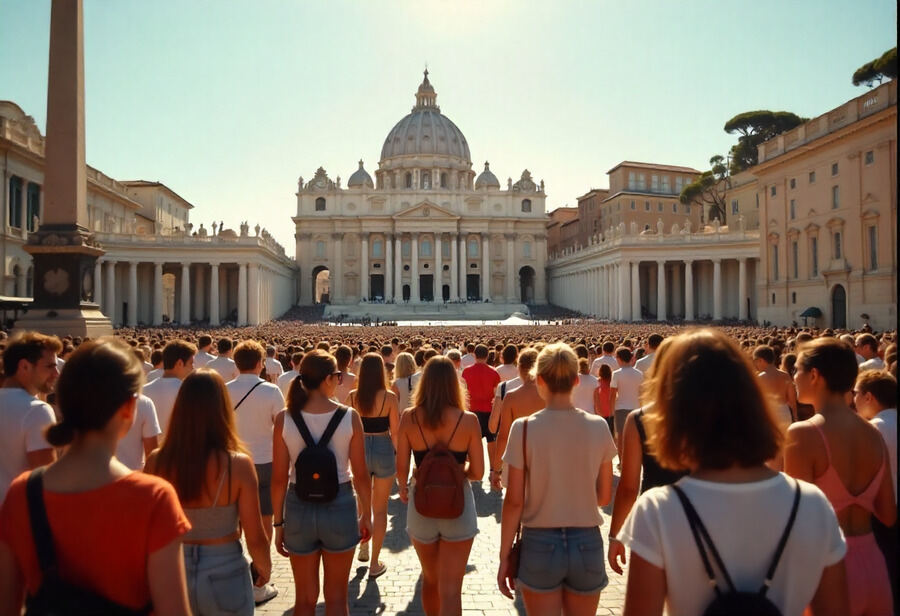Published on
August 20, 2025
In 2025, small nations like Vatican City, Andorra, San Marino, Monaco, Malta, and Saint Kitts and Nevis are grappling with the escalating issue of overcrowded tourism. These destinations, celebrated for their rich history, cultural landmarks, and unique landscapes, have become prime tourist hotspots, attracting millions of visitors each year. The combination of their global appeal, limited space, and small populations has created a perfect storm for overtourism. Affordable travel options, increased connectivity, and the desire for exclusive experiences have contributed to a surge in visitor numbers, putting immense pressure on local infrastructure, resources, and the environment. As these small nations try to balance the economic benefits of tourism with the need to preserve their cultural integrity and ensure a quality experience for both locals and visitors, finding sustainable solutions has never been more urgent.
Vatican City: A Micro-State, Acutely Constrained by Flux
Enclaved by Rome, the Vatican City is an independent polity of 0.44 square kilometres, yet serves as the world’s most visited single square, eclipsing its territorial rivals by sheer density. Tourists now outnumber citizens by an astonishing 7,709 to 1, creating an occupancy asymmetry of historic consequence. The resident enclave comprises 882 persons, predominantly clergy, diplomats, and ceremonial personnel, and is perpetually exposed to waves of pilgrims, tour aggregators, and casual visitors, sustained throughout the calendar.
As the spiritual and administrative nucleus of the Roman Catholic Church, the Vatican commands an enduring global pull. Pilgrimage to its emblematic sites—most notably St. Peter’s Basilica and the Sistine Chapel—cumulatively draws tens of millions each year, artificially inflating the visitation-to-resident ratio. For the micro-state’s unmatched repositories of art, architecture, and restored authority, the consequence is an unresolved conflict between conservation, spiritual observance, and the overwhelming march of megatourism.
Vatican City’s cluster of religious monuments is an established magnet for global travelers, yet managing the tidal wave of traffic remains a daunting, sometimes overwhelming process.
Ranking the Hook: The Top Ten Most Over-Saturated Spots for Travelers
That the Vatican heads the saturation chart underscores a wider tendency, in which territories both small and fiercely coveted are buckling. A shortlist of parallel pressures features the following:
Andorra, San Marino, the Bahamas, Saint Kitts and Nevis, Antigua and Barbuda, Bahrain, Monaco, Malta, and Hong Kong.
These city-states and micro-kingdoms are steeped in heritage and allure, yet their minute land areas and flimsy infrastructure routinely bow beneath the weight of visitor numbers. When demand swells to thrice, or sometimes four times, the resident population, the asymmetry exacts a heavy toll, fracturing amenities, burdening public utilities, and, in quieter evidence, eroding the social fabric.
Consequences Beyond the Glossy Brochure
The concept of overtourism is often relegated to graphic charts or headlines, yet in these settings, the ramifications are immediate and personal. In locales like Hong Kong, Monaco, and the Bahamas, where corridors, coastlines, and public squares absorb the primary surges, the fallout is palpable: transport networks hum at the red limit, waterways suffer slower, thickening decay, and every day’s grocery supply becomes a contest held in queues. Ultimately, the real wealth loses ground, quietly traded for short-lived capital and the strain of a promised peak season that never peaks.
Even the smallest states—Andorra, Malta, or Saint Kitts and Nevis—are adjusting to the reality that, in peak season, short-stay visitors exceed the permanent population. Because the tipping point has been reached, authorities within each jurisdiction rightly warn that further erosion of heritage, crowding of common spaces, and diffuse obnoxious waste are now probable outcomes. In these circumstances, a consensus has emerged that a paradigm shift toward more responsible, wisely calibrated, and profit-oriented travel systems is the only viable prospect.
Moving Toward Sustainable Travel Systems
Repurposing as a solution, destination authorities now favour measurement-led policies that—through evidence and disciplined forecasting—limit guest volume and expand, in any known sequel year, the proportion of tourists hosted in shoulder months. Optional or mandatory fee policies, congestion pricing, and tree or marine planting counts that form a part of visitor purchasing are, for all three examples, surplus supply in the second, cheaper, and greener adjoining months, and lump sum cash forms are now under trial. Because visitor spare pricing was marginal in twenties pricing between the years these experiments began to extend and extend, authorities are leaning toward this the only viable prospect. Only through coherent, shareable, and impulseable visitor electron ticket management would any nation preserve the host and guest interaction.
Conclusion
Vatican City’s emergence as the world’s densest tourist hotspot illustrates the accelerating crisis of overtourism. Millions converge on its monumental precincts annually, imposing strains projected to sharpen in the upcoming decade. To safeguard legendary locales, it is imperative to institutionalize visitation regimes that safeguard cultural patrimony, reassure resident quality of life, and cultivate an equitable, enduring paradigm of travel for succeeding generations.
